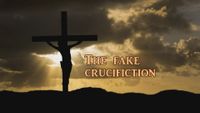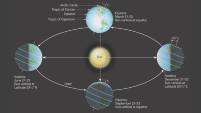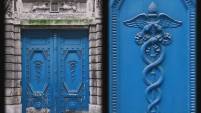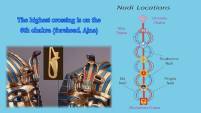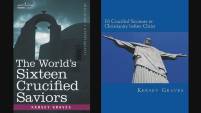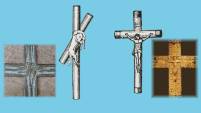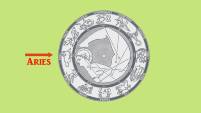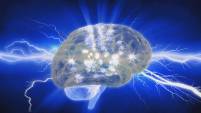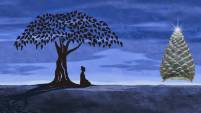Did Jesus really die on the cross?
Who is Jesus?
Is HE just a myth?
In the New Testament, esoteric processes in the human body are portrayed as if they were exoteric historical processes outside the body. For this purpose the numerous occult writings combined to the NT were reinterpreted. The official teaching of the Church is based on this historicizing literal presentation and interpretation. Where the text appears incomprehensible, the "mystery of faith" is spoken of. In the following we give some examples for the two levels of interpretation (the book cover "The Apocalypse Unsealed" by James M. Pryse is shown).
The human being experiences rhythmic passages in his becoming. The most important are known as birth, death and crucifixion. From the point of view of the physical human being, life begins with his birth, with his liberation from the uterus. This birth is celebrated joyfully in the families as a rule. This was preceded by procreation, which he did not consciously experience. Life ends for him in physical death, of which he is afraid. The relatives are grieving.
From the point of view of the immortal soul, the divine spark of man (Manas Buddhi Atman), birth into a physical body - also called incarnation, embodiment - is however a burden, a descent, a being imprisoned. The soul perceives this as the first crucifixion. She takes up the cross of matter and is thus severely restricted in its "freedom of movement". She must live under circumstances that are alien to her. She must perform tasks she does not yet know. She must recognize, understand, comprehend and thereby gain consciousness.
The process in which the soul takes on its cross at birth is also called the attachment to the cross of the sun's course through the zodiac. In the seasonal passage of the sun through the zodiac, the sun passes through four special points:
The Spring Equinox The Summer Solstice The Autumn Equinox The Winter Solstice
These four events are each three months apart and therefore lie at the ends of an equilateral cross: the grand cross of heaven. On this cross every person is "crucified" at every incarnation. He takes part in the course of the sun and that in matter. This fact is reflected in the proverbial "taking up one`s cross", "carrying one`s cross".
The soul perceives physical death as liberation. Many people are very unhappy after near-death experiences in their bodies. They feel as if it was too tight.
"People lost their fear of death. One lives out of love after it", says cardiologist Pim van Lommel in his book "Endless Consciousness. New medical facts about the "near-death experience" whose cover is shown.
In the course of life, the soul can experience a second crucifixion, which usually does not coincide with the end of life. This is not a physical crucifixion by the execution of a death sentence, but a crucifixion in a figurative sense, which is something quite different.
Three nerve pathways run along the human spine. They are "power channels." The central channel is called Sushumna. To the left and right of it two channels with the names Ida and Pingala meander. This is shown on the rod of Mercury (caduzeus). At the upper end sits the pineal gland.
Along the spine there are 7 energy centers (chakras) where the two snakes Ida and Pingala cross. The highest crossing is on the 6th chakra called the forehead chakra (Ajna center). When the two energy paths are fully active and intersect at the Ajna center, one speaks of the second crucifixion, which manifests itself as enlightenment.
The energy in the sushumna then flows in full strength up into the crown chakra (sahasrara chakra). The pineal gland is then fully active. That is why it can be seen at the top of the staff of Mercury. This second crucifixion is for the soul the "fulfillment" of a great number of incarnations; it does not have to incarnate again on earth afterwards. The crucifixion of "Jesus" in the New Testament was such a crucifixion. So he wasn't physically crucified, he didn't die on the cross.
Jesus was therefore often portrayed as the crowned one. Jesus is an artificial figure of the Roman Catholic Church. He is the archetype of the enlightened gnostic. He shows what is possible. "You can do everything I can and much more" (Matth. 21). Jesus is nowhere documented outside the NT in a historically comprehensible way. Three books by Hermann Detering are shown, which prove this statement:
"False Witnesses" - Extra-Christian Jesus Testimonies on the Test Bench.
"Staged Forgeries" - The Pauline Letters in Dutch Radical Critique.
"The Fake Paul" Early Christianity in the Twilight.
However, who is extensively documented by contemporary historians is Apollonius of Tyana, who lived in the first century CE (CE=common era replaced AD=anno domini).
Apollonius as John is the author of the "Apocalypse". He is a travelling teacher as Paul and "Son of God" as Jesus. The ''Last supper'' by Leonardo da Vinci is shown with the apostles' assignments to the signs of the zodiac. Jesus, of course, is the sun.
The Church has concealed the true Apollonius (Gnostic) and (almost) destroyed the fundamental work of the Roman historian Philostratos - which extensively documents the life of Apollonius on the basis of many original sources. Recommendation: the book "Apollonius of Tyana", life and work of an initiate by Maria Schneider from Drei Eichen Verlag
Also on display is the cover of a book by Kersey Graves: "The World`s Sixteen Crucified Saviours" Christianity before Christ, i.e. there are many "crucified", redeemed, enlightened, crowned, anointed, consecrated saviours.
Astrological correlations: The identification mark of the Original Christians was the fish. This symbol is derived from the Anunnaki - Oannes (alias ENKI) was half man half fish. In the NT the apostles are called fisher of men. The whole story takes place at the beginning of the age of Pisces. It was not until the Council of Ephesus in 431 CE that the cross was introduced as a logo. However, this cross did not carry a man but a lamb. At the 6th Ecumenical Council of Constantinople in 680 CE the Lamb was replaced by "Jesus". In the New Testament "Jesus" is regarded as the Lamb of God, who takes away the sins of the world. This must not be taken literally.
An enlightened human being (Gnostic) has overcome his lower nature (his animal qualities) himself - the so-called carnal lust - as well as his "false thinking" (imaginative and wishful thinking). An enlightened one shows other people what is possible. However, he cannot relieve them of their own "work". Every human being is obliged to understand independently and to grow in consciousness.
The lamb (actually a RAM) corresponds to the zodiacal sign Aries. "Lamb of God" sounds better than "Ram of God." Aries begins on 21 st of March at the time of the spring equinox. That is, the lamb is fixed to the grand cross, is crucified. Aries is astrologically assigned to the human head. There the crucifixion (enlightenment) takes place. In the enlightenment report of the archetype "Jesus" this took place on the top of a mountain called "Golgotha", which means "skull place". However, this mountain was never found, the skull place is in the head of Jesus. The crucifixion takes place in man himself.
The "Apocalypse" (Book of Revelation) of "John" = Apollonius is a detailed description of the enlightenment process of man. The Seven Seals are the Seven Chakras. The Apocalypse is not a prophetic scripture that predicts the end of the world. It was encrypted to preserve the information for posterity. The essence of man lives forever, we only change form.
Summary
1. The Jesus of the Roman Catholic Church is an artificial figure, which is nowhere verifiably documented outside of the NT.
2. Historically proven is an enlightened contemporary: Apollonius of Thyana, who however does not represent a savior figure and pointed to personal responsibility and the divine essence of every human being.
3. He was divided among the three artificial figures of Jesus, Paul and John. He is the author of the apocalypse/revelation, which describes the enlightenment process.
4. Christianity, like most religions, is a sun cult. All crucial figures are myths as well as archetypes and are represented as suns.
5. The so-called Christianization of the pagans is only a renaming and a change of power. Religions are always primarily about the exercise of power.
It is probable that a mystic, gnostic, healer, itinerant preacher by the name of Jesus/Joshua also lived and worked beneficially among the people.
7. The crucifixion is a symbol of the enlightenment process in the skull (Golgotha), the opening of the crown chakra.
8. Spiritual writings deal with immaterial processes for which there are no clear terms in everyday language. Therefore, symbols, parables, fables, etc. are used.
9. It is about heightened perception as well as expansion of consciousness. In the process, each person develops his or her own individual truth, which takes him or her further.
10. This is based on own experiences as well as individual grasping. It is not about proof or persuasion. Intuition tells him what is true for him in each case.
